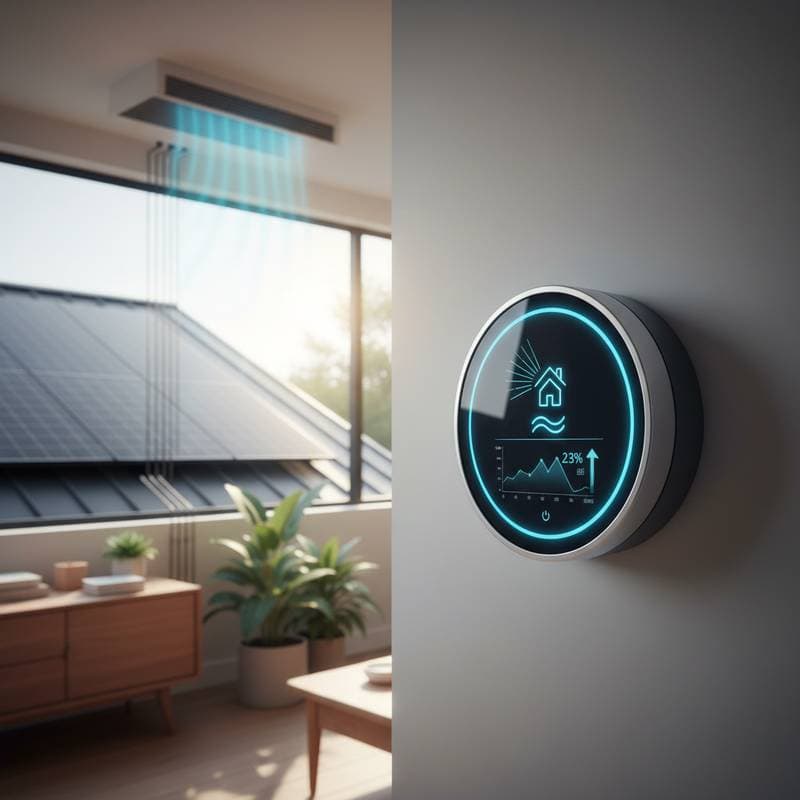How Smart Thermostats Increase Solar Savings by 23%
United States households equipped with rooftop solar systems achieve notable efficiency improvements when integrating smart thermostats. Recent data indicates an average 23 percent rise in overall energy savings. This pairing of adaptive HVAC controls and on-site solar production transforms residential energy management, balancing comfort and usage effectively.
Performance data from various energy management platforms, which monitor electricity in solar homes, supports these findings. Thermostats that adjust heating and cooling based on solar generation lead to steeper declines in utility bills compared to traditional programmable models.
Analysts note this trend underscores distributed energy integration. Connected devices now collaborate with solar inverters and batteries to flatten demand and boost self-consumption.
Aligning Solar Output with HVAC Needs
Smart thermostats adapt to occupant habits, weather conditions, and equipment efficiency. Linked to solar arrays, they serve as tools to match energy use with peak production times.
For instance, during high solar hours around midday, the thermostat precools or preheats spaces. This reduces evening HVAC demands when grid power costs more. Such load shifting proves valuable in areas with time-of-use pricing that charges higher rates during peak periods.
Jason Miller, senior product manager at Ecobee, explains that connecting thermostat algorithms to solar inverters elevates energy independence. “We are no longer talking about passive energy savings,” Miller said. “The system makes real-time decisions based on available generation, which means a household is maximizing the value of every kilowatt it produces.”
System Integration Mechanics
Beyond simple software connections, integration uses protocols like MQTT and Modbus for device communication. These enable exchanges of inverter data, weather forecasts, and HVAC metrics.
Solar inverters track voltage, current, and power across circuits, mapping household energy flows. Shared with thermostats, this information allows adjustments to temperature settings or fan operations, preserving comfort while minimizing grid dependence.
Brands such as Google Nest and Honeywell Home offer APIs for solar systems to share real-time data. Installers observe steadier energy patterns and better battery performance in setups with storage.
Measuring the 23 Percent Gain
This 23 percent figure combines lower grid use and shorter HVAC cycles, drawn from thousands of United States homes. Wood Mackenzie analysts examined utility rebate data for solar customers and confirmed uniformity across climates and system scales.
In a standard 6 kW home solar setup, coordination adds about 1,200 kilowatt-hours in yearly savings. At typical rates, this equals around 100 dollars in further bill cuts, with greater returns alongside batteries.
Maya Lopez, energy efficiency analyst at the Solar Energy Industries Association, affirms the value of hybrid controls. “Solar generation is variable by nature,” Lopez said. “Smart thermostats turn that variability into an advantage by adjusting loads automatically. The performance improvement is not theoretical, it is measurable and repeatable.”
Incentives and Policy Support
Utilities in several states extend rebates to smart thermostats within demand response initiatives. These programs aim to ease grid peaks by sending control signals to enrolled devices.
Paired with solar, they enhance outcomes. Daytime solar producers export surplus power while cutting HVAC loads, aiding grid stability and emission goals.
The United States Department of Energy praises connected thermostats for cost-effective distributed management. State offices now mandate renewable interoperability for rebate devices, avoiding vendor lock-in.
Practical Installation Steps
Installers face added coordination when combining thermostats with solar. Contractors check inverter data access, network reliability, and control settings.
Engineering, procurement, and construction firms often include thermostats in solar packages for homes and small businesses. Ryan Keating, operations director at SunTech Renewables in Arizona, notes rising demand for full energy solutions. “We include the thermostat in nearly every new system,” Keating said. “It simplifies the sales process by showing tangible comfort benefits alongside energy savings.”
Thermostats typically use existing wiring. The main task involves setting up data flows for accurate production reads, via cloud or local networks.
Revenue Potential for Installers
Solar businesses find opportunities in smart management add-ons. Packaging thermostats with controllers and software raises project values and sets firms apart.
Projections suggest most residential solar installs will soon feature extra connected devices. These yield sales plus ongoing revenue from subscriptions and analytics.
Data on HVAC patterns lets installers advise on fixes, upgrades, or batteries. This fosters loyalty and referrals in price-competitive markets.
Advancing Whole-Home Optimization
Thermostats fit into larger energy orchestration trends, alongside electric vehicles, heat pumps, and batteries.
The solar sector now prioritizes load coordination over generation alone. A National Renewable Energy Laboratory report shows smart load controls can cut grid imports by 40 percent in solar-dense areas. Thermostats play a key role in demand shaping.
Overcoming Adoption Hurdles
Privacy worries about cloud connections and utility overrides slow uptake. Manufacturers counter with local options and clear policies, plus standards for compatibility.
Upfront costs exceed basic models, though payback occurs in two to three years. Bundling into solar financing eases this for customers.
Variations by Region
Gains differ by climate. In sunny Texas and Arizona, cooling-focused savings lead. Northern utilities see up to 15 percent drops in evening heating demands, aiding renewables.
Evolving with Battery Systems
Future advances link thermostats more closely to inverters and batteries. Forecasting production and charge levels schedules HVAC to leverage storage off-peak.
Enphase Energy and SolarEdge test algorithms for thermal and battery coordination. Mature systems could surpass 23 percent savings using predictive tools for weather and pricing.
Realizing Smarter Energy Benefits
Smart thermostats with solar mark progress in responsive home energy use. The 23 percent savings highlight how controls turn intermittent power into reliable gains.
Homeowners gain comfort and savings. Installers build diverse services and ties. As standards evolve, solar and management merge further, refining efficiency incrementally.
